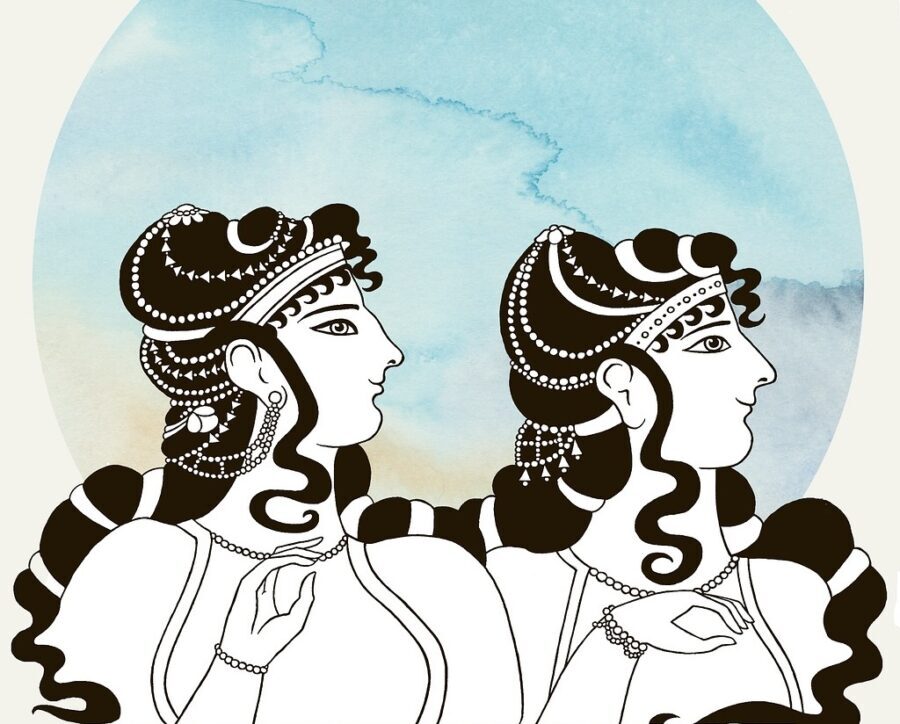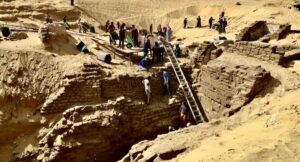
El Araba El Madfuna, meaning ‘the Buried Wagon’ in arabic, otherwise known as Arabeh el-Madfuna, “the buried Arabah”, is a small Egyptian town on the edge of the desert, 9 miles west of the Nile on the western side of the Nile valley. Settled about 300 miles south of the massive population center of Cairo and the iconic Giza pyramids, by itself it does not attract much attention. But very near to the town are the monumental remains of Abydos, a place that draws thousands of visitors every year. Considered one of the oldest cities of ancient Egypt, it is also known for its significance as one of the most important religious centers of Egyptian civilization, centered around the cult of Osiris and Isis, and the burial place of Egypt’s first pharaohs (ca. 3000-2800 BCE). Walking among its silent stones, one cannot help but feel the heat of the desert sun kissing this place with a sense of sterile purity, sanctifying it over 5,000 years with a deeply and uniquely ancient Egyptian spirituality. Here was Egypt’s main center dedicated to the worship of Osiris, god of the afterlife, resurrection, fertility, agriculture, life, and vegetation. Spanning multiple dynasties and kingdoms, it was, for the ancient Egyptians, the “go-to” place at the heart of their religion and storied beginnings.
___________________________

The interior of the iconic Temple of Seti I at Abydos. From the earliest times, Abydos was the center of the rising cult of Osiris and Isis. The temple contains an inscription known as the Abydos King List. Vyacheslav Argenberg, CC BY 4.0, Wikimedia Commons
___________________________
Recent decades have seen Abydos slowly resurrect under the methodological hands of archaeologists….
Excavations at Anubis-Mountain
It was in 1901 when the tomb of the 12th Dynasty Middle Kingdom pharaoh Senwosret III (who reigned ca. 1880-1850 BCE) was first discovered. Among the largest royal tombs of ancient Egypt, the tomb complex and the area around it has been under investigation since 1994 by teams from the University of Pennsylvania’s Museum of Archaeology and Anthropology (Penn Museum), currently headed by Josef Wegner, as part of the combined University of Pennsylvania-Yale-Institute of Fine Arts/New York University Expedition in cooperation with the Egyptian Ministry of Tourism and Antiquities. The excavations have focused primarily on Senwosret’s subterranean tomb, his mortuary temple and associated structures, a related royal town settlement known as Wah-Sut, and a New Kingdom cemetery further to the north. Senwosret was significant for a number of reasons, not the least of which was the nature of his burial—instead of being interred within a traditional royal pyramid like his forerunners, he chose to be buried in a subterranean tomb. This was a first, giving rise eventually to the well-known underground tomb concept popularly associated with the royal tombs of the New Kingdom pharaohs in the Valley of the Kings. The tomb is located near a peak in the cliffs near the excavations, a place ancient texts have designated as “Anubis Mountain,” a sacred mountain, and thus the work has been popularly penned as the Anubis Mountain excavations.
Particularly since 2014, extraordinary new discoveries have come to light that are beginning to change what we know about a relatively obscure time in ancient Egyptian history, the Second Intermediate Period and the mystery of the lost Abydos Dynasty.
________________________

Panorama of the landscape of the Anubis-Mountain necropolis. Courtesy Josef Wegner and the Penn Museum, as published at Popular Archaeology, June 14, 2017, A Pharaoh’s Massive Tomb Unveiled
________________________
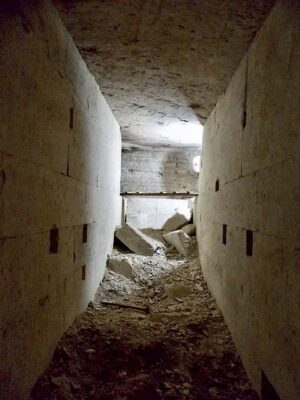
Above and below: Views within the newly revealed massive tomb complex of Senwosret III. Note the remarkable interior of well-dressed masonry. Courtesy Josef Wegner and the Penn Museum, as published at Popular Archaeology, June 14, 2017, A Pharaoh’s Massive Tomb Unveiled
________________________
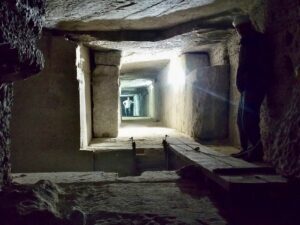
________________________
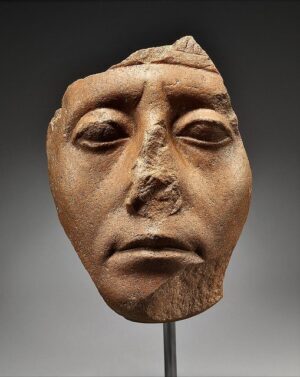
Senwosret III at the Metropolitan Museum of Art. Gift of Edward S. Harkness, 1917. http://www.metmuseum.org/art/collection/search/544186, CCO 1.0 Universal, Wikimedia Commons
________________________
The Tomb of the Warrior King
Winter, 2014 — The first clues were nothing extraordinary—a line of mudbricks in the sand, not unlike the first evidence of many of the other tombs already found in this ancient, sacred place.
But digging down further, the excavators could see something different about this one. The line of bricks eventually became walls, and the walls became a decorated burial chamber. Wall paintings depicted images of the Egyptian gods Isis, Nut, Nephthys, and Selket, surrounding a canopic shrine. Among the paintings was a royal cartouche. Cartouches always meant names. This one belonged to ‘Woseribre Senebkay’—a virtual unknown among the pharaonic lists. The tomb had all the hallmarks of a royal tomb, but the name didn’t ring any bells for the excavators.
Who was this Senebkay?
Further excavation of this mystery tomb revealed an antechamber (now dated to Egypt’s Second Intermediate Period, or 1650 to 1550 BCE) containing skeletal remains, presumably of Senebkay himself. Also with his remains was his canopic chest, and fragments of a mummy mask. The condition and positioning of the objects had all the signs that the tomb had been plundered anciently by robbers—what was left was only debris, his mummy having been torn apart in antiquity, his coffin and canopic chest in fragments, and the original gild surfaces of his other tomb equipment long gone. But for archaeologists, there was enough information here to keep them busy for years. The skeletal remains alone contained a wealth of information, and as modern forensic science would have it, the scientists were in for a fascinating up-close-and-personal encounter with a pharaoh who, until January, 2014, no one knew existed.
___________________________
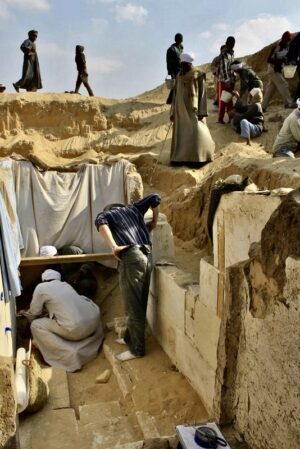
Team members work to excavate the burial chamber of the pharaoh Woseribre Senebkay, with sheets covering a painted wall decoration. Photo: Josef Wegner, Penn Museum. From The Tomb of the Warrior King, March 16, 2015, Popular Archaeology
___________________________

The exposed tomb of Woseribre Senebkay. Here, a LiDAR instrument and spheres were set up to create a precise digital map of the tomb. As an essential part of investigating the area in which the tomb was located, researchers utilized technology such as LiDAR ( Light Detection And Radar), as well as magnetometry and ground penetrating radar. Photo courtesy Paul Verhelst. From The Tomb of the Warrior King, March 16, 2015, Popular Archaeology
___________________________
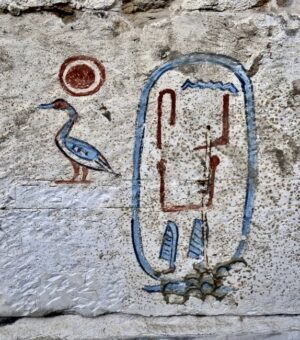
At left, the sun disc and goose means “Son of Re” (or Ra), the Egyptian sun god. The cartouche at right spells the name of the pharaoh, Senebkay, whose body was interred in this tomb. Photo: Jennifer Wegner, Penn Museum. From The Tomb of the Warrior King, March 16, 2015, Popular Archaeology
___________________________
A Violent Death
Initial examination of Senebkay’s skeleton by University of Pennsylvania graduate students and team members Paul Verhelst and Matthew Olson suggested the king was moderate in height, about 5’10, and that he died in his mid-to-late 40s.
But further study revealed much more. A more detailed examination by Dr. Maria Rosado and Dr. Jane Hill of Rowan University pinpointed his death at 35 to 40 years of age, and showed clear evidence of multiple wounds to his body. They documented no less than 18 wounds, including cuts to his lower back, knees, ankles, feet, and hands. But, according to the examiners, death likely came as evidenced by three major wounds to his skull. More telling, the wounds matched the distinctive size and shape of well-known battleaxes used in warfare during Egypt’s Second Intermediate Period. And more telling still, the pattern of most of the wounds suggested that they had been inflicted while he was in an elevated position.
A few possible scenarios could explain this. One stands out—evidence on the femur and pelvis bones of muscle attachments indicated he had spent a significant amount of his life on horseback.
Was Senebkay slain in battle or in an ambush while on horseback?
The researchers suggest this as a real possibility. He may have been, like other pharaohs known from later periods, a warrior king, fighting alongside his troops. Another king’s remains, discovered in a tomb near Senebkay’s, also indicated a life of horseback riding, additional evidence that Second Intermediate Period kings were already riding horses, a skill that was not known to have been commonly employed in battle until after the Bronze Age. Was horseback riding beginning to play an increasing role in military campaigns as early as the Second Intermediate Period? The researchers hope that further discoveries and research will shed more light on the question.
In any case, for the first time, archaeologists had what appeared to be first evidence of a long-forgotten Egyptian pharaoh who likely met a dramatic and viciously dealt death—what today could be the stuff of a cinematic production.
Other key questions revolve around whom he might have fought and where the battle took place, assuming by interpretation that he died in battle. His remains indicated that a significant amount of time passed between the time of his death and actual burial, suggesting that his body may possibly have been transported from a distant location to the place of burial. But this is where the evidence stops. Based on what scholars know about the history of the region, the king may have died fighting the Hyksos. The ancient record reflects 15th Dynasty Hyksos rule of northern Egypt at that time. Alternatively, he may have died in battle against possible enemies such as the 16th Dynasty Thebans to the south, or the Nubians, who according to written records from his time invaded Egypt from the south at least once. These are questions that await further research.
_____________________________
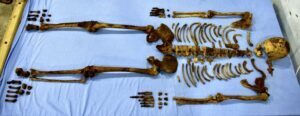
The skeleton of pharaoh Woseribre Senebkay. Originally mummified, the body was ripped apart by robbers in antiquity. Photo: Josef Wegner, Penn Museum. From The Tomb of the Warrior King, March 16, 2015, Popular Archaeology
_____________________________
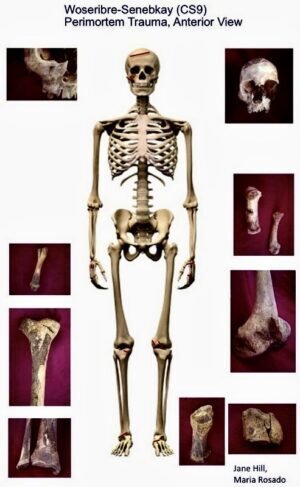
Schematic showing the distribution of traumatic battle wounds to Senebkay: front view. Image: Dr. Jane Hill. From The Tomb of the Warrior King, March 16, 2015, Popular Archaeology
_____________________________
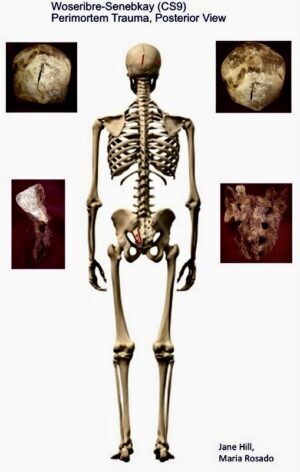
Schematic showing the distribution of traumatic battle wounds to Senebkay: rear view. Image: Dr. Jane Hill. From The Tomb of the Warrior King, March 16, 2015, Popular Archaeology
_____________________________
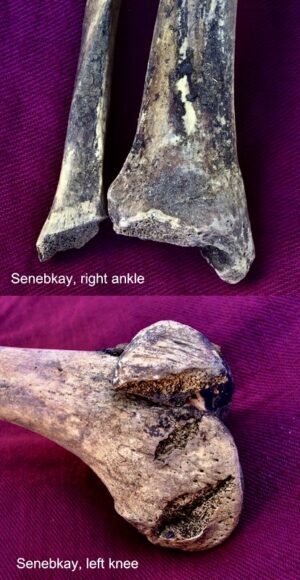
Image composite depicting the right ankle and left knee of Woseribre Senebkay’s skeleton. The patterns of wounds to Senebkay’s body suggest he was attacked while in an elevated position relative to his assailants, quite possibly mounted on horseback. Image: Jane Hill and Josef Wegner. From The Tomb of the Warrior King, March 16, 2015, Popular Archaeology
_____________________________
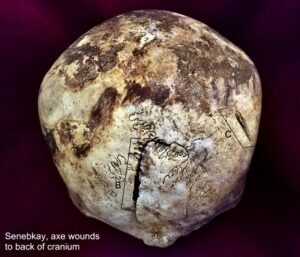
Rear view of Woseribre Senebkay’s skull, indicating the locations of two axe wounds to the back of the cranium. Photo: Jane Hill and Josef Wegner. From The Tomb of the Warrior King, March 16, 2015, Popular Archaeology
_____________________________
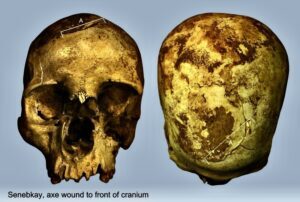
Front and top views of Woseribre Senebkay’s skull, indicating the location of an axe wound to the front of the cranium. This and two other major blows to Senebkay’s skull preserve the distinctive size and curvature of battle axes used during Egypt’s Second Intermediate Period. Photo: Josef Wegner, Penn Museum. From The Tomb of the Warrior King, March 16, 2015, Popular Archaeology
_____________________________
A Dynasty Lost and Found
As the excavators found, the tomb of Senebkay proved to be comparatively modest in scale and showed reuse of materials from the earlier Middle Kingdom, such as decayed cedar wood remains of his canopic chest, which still bore the name of Sobekhotep I beneath its gild covering. This, along with other evidence, suggested a kingdom with far more limited resources than the previous Middle Kingdom. But the discovery provides new evidence of the existence of a forgotten Abydos Dynasty contemporary with the 16th Theban Dynasty to its south and the 15th Hyksos Dynasty to its north.
There is now evidence for 18 royal tombs spanning the period of this lost dynasty. Tombs of nine of them have been excavated, of which Senebkay’s, dated to 1650 BCE, is one, revealing clues to a time and series of pharaohs that until now were not known to exist.
Who were these kings and what was their place in history? Sandwiched between their Hyksos and Theban Dynasty contemporaries, did they vie with them for power and control of all of ancient Egypt, or simply defend themselves in efforts to hold on to what they had, including invasions from the Nubians further to the south? Do Senebkay’s fatal wounds tell a story that could have anything to do with any of these potential scenarios? Wegner’s team, including other researchers, may find answers to these questions as they continue their investigations. Senebkay’s tomb, was, in fact, one of eight relatively small tombs clustered within preexisting enclosures in the same area that has been investigated by Wegner’s team, all exhibiting similar structural characteristics and dates and pointing to the existence of a previously unknown dynasty.
The Tomb of the Unknown King
Investigations and excavations at Anubis-Mountain did not stop with the Senebkay tomb. Something remarkable happened again in January, 2025, as the team was investigating an ancient large brick enclosure that included the previously identified tomb of Pharaoh Neferhotep I.
Digging down through the sand in the corner area of the great enclosure, the excavators could see the signs of the destructive work of ancient tomb robbers, then features of massive brick walls. The slow, grudging work of digging through the sand deposits then began to give way to a very different feeling.
_____________________________
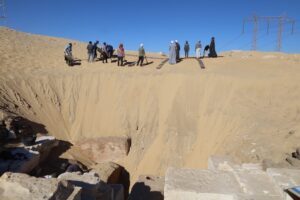
Digging through the sand deposits, something remarkable emerges. Dr. Josef Wegner for the Penn Museum
_____________________________
“It was a very exciting discovery when we realized we had come upon yet another royal tomb,” said Wegner.
At about 23 feet below the surface, the telltale features of the tomb began to emerge. Built of limestone, it was large, with a decorated entryway and other chambers capped by 16-foot-high vaults made of mudbrick.
_____________________________
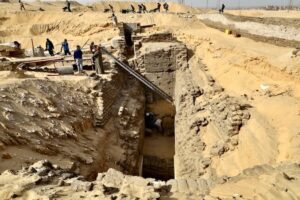
The features of the tomb structure began to emerge after painstaking excavations.Image: Dr. Josef Wegner for the Penn Museum.
_____________________________
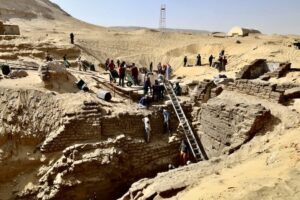
Photo: Dr. Josef Wegner for the Penn Museum.
_____________________________
They estimated it to be 3,600 years old, set within the Egyptian Late Middle Kingdom—early Second Intermediate Period, a time just before the period of instability when Egypt splintered into rival, warring kingdoms. This tomb exhibited architectural and decorative features very similar to that of the Senebkay tomb, albeit much larger, supporting the archaeologists’ suggestion that the ruler to whom the tomb belonged may have been a predecessor, possibly Senaiib or Paentjeni, who, like Senebkay, were kings of the little-known Abydos Dynasty, but whose tombs have not yet been found.
_____________________________
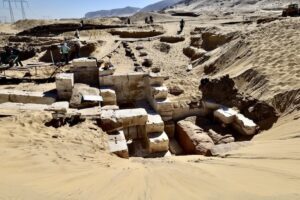
Image: Dr. Josef Wegner for the Penn Museum
_____________________________
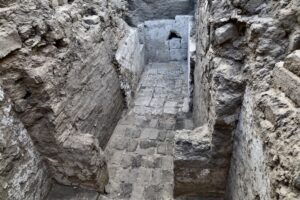
The 3,600-year-old limestone tomb chamber. Image: Dr. Josef Wegner for the Penn Museum
_____________________________
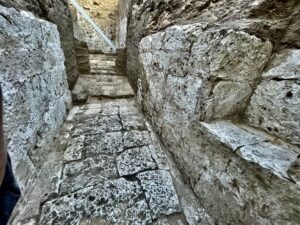
Image: Dr. Josef Wegner for the Penn Museum
_____________________________
As excavators cleaned and defined the walls of the tomb, they could see scant remaining traces of polychrome wall paintings, scenes that appeared to depict the goddess Isis, the goddess of healing and motherhood, and Nephthys, her sister, who is frequently shown with Isis in funerary contexts. Moreover, excavators could see that the pharaoh’s name was likely originally once painted into scenes depicted on the plaster and brickwork that decorated the burial chamber entrance. Unfortunately, the work of ancient tomb robbers had significantly erased most of the hieroglyphic text. Not enough of the text has survived to afford identification of the pharaoh’s name.
______________________________
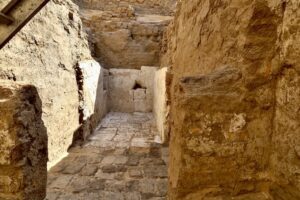
The limestone burial chamber featured a decorated entryway. See traces of decoration on the right. Image: Dr. Josef Wegner for the Penn Museum
______________________________
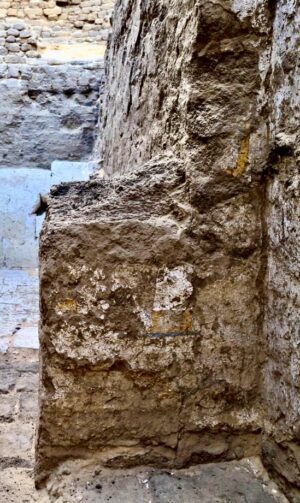
The unknown king’s name was painted on ancient plastered brickwork leading to the limestone chamber, but ancient tomb robbers damaged the hieroglyphic texts. Image: Dr. Josef Wegner for the Penn Museum
______________________________
As Wegner and the archaeological team continue to dig and investigate, more and more about the obscure Abydos Dynasty is coming to light. According to Dr. Wegner, the tomb discovery confirms there are likely additional early kings buried in, and around, the nearby large tomb enclosure of the pharaoh Neferhotep I, the 13th Dynasty king who ruled a century before the Abydos Dynasty. The enclosure area interior and associated tombs have been under systematic investigation by the Wegner team. Another large tomb, which, like the others, was found to have been plundered of its treasures as well as architectural stones during the Second Intermediate Period, is thought to be that of king Sobekhotep IV, Neferhotep’s brother. Both kings were considered active in the Abydos area during their reigns.
Investigations and excavations at Anubis Mountain will continue through the application of the latest technology, including remote sensing, photogrammetry (three-dimensional modeling of the tombs) and magnetometry(magnetic mapping).
“We have a series of tombs,” says Wegner. “It’s exciting to find not just the tomb of one previously unknown [now identified] pharaoh, but the necropolis of an entire forgotten dynasty,” stated Dr. Wegner in a Penn Museum press release. “Continued work in the royal tombs of the Abydos Dynasty promises to shed new light on the political history and society of an important but poorly understood era of Ancient Egypt.”*
_______________________________
See more about the Penn Museum, located in Philadelphia, Pennsylvania.
_______________________________
Advertisement
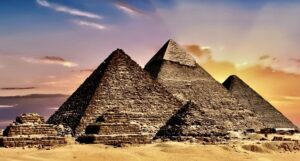
See the monumental discoveries at Abydos in person! Join Popular Archaeology Magazine and an Egyptologist on a specially organized land and Nile cruise tour of ancient Egypt’s most iconic sites, to include the Grand Egyptian Museum and the spectacular treasures of Tutankhamun, the tomb of Tutankhamun, the pyramids of Giza and the Great Sphinx, the necropolis of Saqqara, Abydos, the Valley of the Kings, Luxor, and many other iconic tomb and temple sites. This tour is planned for the late fall of 2026 or early spring of 2027. It includes an optional extension to Amman, Petra and the Dead Sea in Jordan. The cost of the 13 -day core Egypt tour is estimated to be between $3,500 and $4,400, excluding airfare. Email populararchaeology@gmail.com to express interest and to receive more information!

